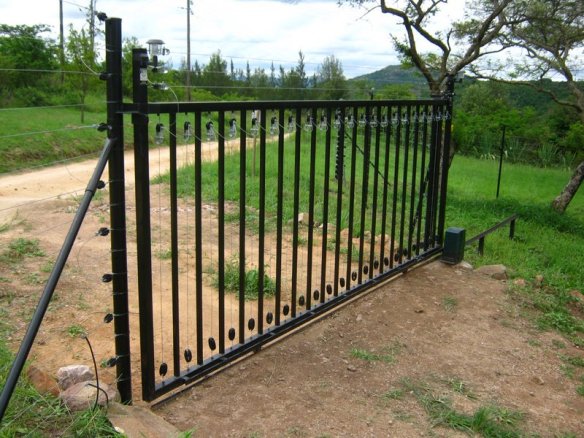On arrival on the farm in Nelspruit my first task was to secure the property. Living out here, we all need lots of dogs, but to keep the baddies out and the dogs in, we need a fence.
Not just any fence will surface, it needs to be electrified.
Building an electric fence is not brain surgery, but it is a lot of work and takes a lot of planning. Werner @ Forest Wire here in Nelspruit helped me with the planning and I bought the majority of my parts from him.
You will need to plan the layout of the fence and also the pulse flow down the wire, determining exactly were it will just from strand to strand to navigate your entire fence.
You will also need to plan earth spikes that earth the whole fence and help safeguard it from lightning strikes too.
Its inportant that you plan out exactly what parts you need and how many of them.
For a fence like this it this takes time to calculate.
An electric fence comprises the following, so tick them off one by one and calculate what you need, your budged etc.
You will need:
Gate posts for either side of any aperture.
Corner posts for any corner or angle that the fence will take.
Corner supports, 45 deg support posts that stabilise your corner posts.
Y-standards, thin metal posts that support the strait lengths of your fence and support all the strands.
Lots and lots of wire, I got the top banana uber galvanised type, so it should last well.
Shielded wire for carrying the electrical pulse under fences or though conduite.
Tensioners that tension the individual strands of wire.
Isolators, the plastic isolators that insulate the charged wires from the gate posts etc.
Line clamps, little metal clamps that clamp wires together when connecting wire together to direct current flow.
Plastic bobbins, these isolators tie to your Y-standards and isolate the strands while holding them in place.
Next you need your car gate and any pedestrian gates you want.
Include in your calculations if you want strands within these gates, if so you will need all those parts and connections to carry your current onto the gates.
For the car gate I used a gate contact, a spring and pin contact that electrifies the car gate when closed.
In addition to your gate you will need a gate rail for it to run on and that will need to be cemented into the ground well.
Your gate motor will need to be installed onto a plate and mounted correctly into the foundation to propel the gate.
Electrical conduit will be required to power the gate, unless your running off solar, so don’t forget to budget and plan for that.
Finally you need your energizer
This supplies the pulse for the fence that shocks a would be intruder or escapee.
Your energiser needs to be mounted inside somewhere accessible and shielded strands need to be run out to your fence. Chat to your supplier as the size of your energizer will be based on the distance of strands you are installing.
The strands to your energiser need to to cater for a pulse out, pulse return and your earth wire. Your earth wire should also run through 2 or 3 well spaced earth spikes on the way to the fence connection.
I also included two lighting diverters that reduce the chance of damage to my energiser in the case of a strike.
All in all its a big job.
The planning needs to be done carefully. Make use of any advice you can get.
Check and recheck.
Prep the land before hand, get it nice and flat.
Get your fence strait, its very satisfying when your done and its spot on!
Buy everything in one go so that you can start the job and get it done, missing a part can cause annoying delays.
Account for wastage, there will always be a little wastage with wire as you need an extra bit to work and wind it.
Use the right tools.
There will be millions of connections and working with wire destroys your hands.
Make the foundations of your corner posts bigger than you think they should be and be generous with your cement.
I use 16 strands and their combined force is hectic.
If your working in the heat, any parts that can be pre wound, do it in front of the TV at night or under a tree out of the sun.
When working out on the farm, carry all the tools you could possibly need. Going back and forth to fetch tools will drive you insane.
Paint the fence up well, use a hard-wearing, fast drying, tough commercial paint.
In closing, I would say that it is very rewarding doing it yourself. Its hard work, but totally do-able, if your handy, give it a go, it aint brain surgery, you’ll be fine 🙂
Best of luck
see the photos here.


